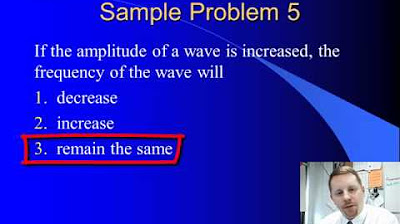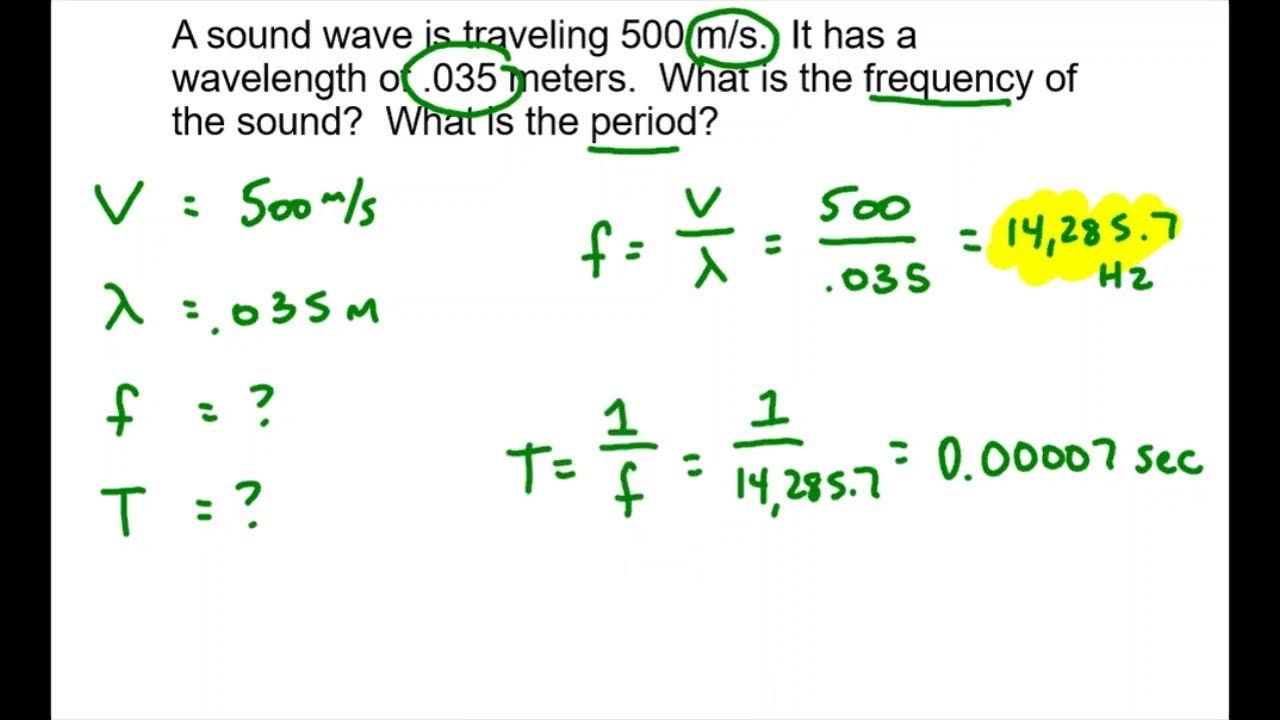Grade 10 Physics Transverse waves Period and Frequency
TLDRThe video script offers a comprehensive explanation of the concepts of period and frequency in the context of transverse waves. It emphasizes the period as the time taken for one complete wave pulse and frequency as the number of wave pulses passing a point per second, highlighting their reciprocal relationship. The script uses diagrams and examples to illustrate how to determine period and frequency from a graph and explains how to calculate one from the other using their formulas. The content is informative, engaging, and well-suited for educational purposes.
Takeaways
- 📌 The period (symbol 𝑇) of a wave is the time taken for one complete wave pulse and is measured in seconds.
- 📌 The unit of measurement for period is seconds, and it's crucial to write 's' or 'seconds' when noting the unit to avoid marking down in exams.
- 📌 To identify the period from a graph, one must understand points in phase and find the time between two successive points or from crest to crest.
- 📌 Frequency (symbol f) is the number of wave pulses that pass a given point per second and is measured in Hertz (Hz).
- 📌 Period and frequency are reciprocals of each other, meaning the period is equal to 1 divided by the frequency, and vice versa.
- 📌 The formula to calculate frequency from period is 𝑓 = 1/𝑇, and to calculate period from frequency is 𝑇 = 1/𝑓.
- 📌 If a pattern takes 4 seconds to complete from point A to F, the period is the time for one wavelength, which is half of the 4 seconds, thus 2 seconds.
- 📌 When dealing with wave properties, it's important to distinguish between symbols and units, and to be precise with the terminology used.
- 📌 In examples, if 10 wavelengths pass a point in 1 second, the frequency is 10 Hz, and the period is 1/10 of a second or 0.1 seconds.
- 📌 A common examination question involves calculating the period or frequency based on given information about wave pulses or wavelengths passing a point in a specified time.
- 📌 Understanding and applying the concepts of period and frequency is fundamental to the study of wave properties and is often tested in examinations.
Q & A
What is the definition of the period of a wave?
-The period of a wave, symbolized as Big T, is the time taken for one complete wave pulse to pass a given point. It is measured in units of time, typically seconds.
How is the period of a wave different from its unit of measurement?
-The period is a measure of time and is represented by the symbol T, whereas the unit of measurement for period is seconds (s or sec). The symbol is a shorthand way of representing the period, not the unit itself.
What is the significance of understanding points in phase when determining the period from a graph?
-Understanding points in phase is crucial for identifying one complete wave or wavelength on a graph, which is necessary to accurately calculate the period of the wave.
How can you find the period of a wave from a graph?
-To find the period from a graph, one must look at the x-axis, which represents time, and identify the time interval between two successive points in phase, such as from one crest to another crest.
What is the relationship between the period and the wavelength of a wave?
-The period and the wavelength of a wave are directly related. The period is the time it takes for one complete wave to pass a point, while the wavelength is the spatial distance between successive points in phase. They are essentially the temporal and spatial aspects of a wave's cycle.
What is the definition of frequency in the context of waves?
-Frequency, symbolized as f, is the number of wave pulses that pass a given point per second. It is the inverse of the period and is measured in Hertz (Hz).
How can you calculate the frequency of a wave if you know its period?
-The frequency of a wave can be calculated by taking the reciprocal of the period. If the period (T) is known, the frequency (f) is given by the formula f = 1/T.
What is the significance of the reciprocal relationship between period and frequency?
-The reciprocal relationship between period and frequency means that if you know one, you can immediately determine the other. This is useful for converting between time-based and count-based descriptions of wave behavior.
How can you determine the period of a wave if you are given the frequency?
-If the frequency (f) is known, the period (T) can be determined by taking the reciprocal of the frequency. Using the formula T = 1/f, you can calculate the period in seconds.
What happens to the frequency of a wave if the period decreases?
-If the period of a wave decreases, the frequency increases. This is because frequency and period are inversely related; a shorter period means more wave pulses occur in a given time frame.
How can you calculate the period of a wave if it takes 4 seconds to complete a pattern from point A to F?
-If it takes 4 seconds to complete the pattern from point A to F, and this pattern represents two wavelengths, then the period, which is the time for one wavelength, is half of 4 seconds, which is 2 seconds.
If 10 wavelengths pass a certain point in 1 second, what is the period of the wave?
-If 10 wavelengths pass a point in 1 second, the frequency is 10 Hertz. To find the period, you use the formula T = 1/f, which gives T = 1/10, resulting in a period of 0.1 seconds or 100 milliseconds.
Outlines
📚 Introduction to Period and Frequency in Transverse Waves
This paragraph introduces the concept of period and frequency in the context of transverse waves. The period, denoted by the symbol 'T', refers to the time taken for one complete wave pulse to occur. It is emphasized that the period is measured in seconds and is associated with time. The explanation includes a discussion on the difference between a symbol and a unit of measurement, highlighting the importance of using the correct notation, especially in an examination setting. The paragraph also touches on how to identify the period from a graph, explaining the need to understand points in phase and using a diagram to illustrate the concept. The challenge of reading the period from a graph is addressed, along with a practical example of determining the period from a手绘 wave graph.
🔍 Analyzing Period and Frequency through Wave Patterns
This paragraph delves deeper into the analysis of period and frequency by examining wave patterns. It explains how to determine the period of a wave by counting the number of waves between two points and calculating the time taken for a single wave to pass a specific point. A tricky question from a past paper is used to illustrate the method, emphasizing the importance of understanding the relationship between the number of waves and the time interval. The concept of frequency, denoted by 'f', is introduced as the number of wave pulses per second, with Hertz as the unit of measurement. The reciprocal relationship between period and frequency is highlighted, providing formulas for calculating one from the other. The paragraph concludes with a series of quick questions to test the understanding of the concepts discussed.
📈 Calculation of Period and Frequency with Examples
This paragraph focuses on the calculation of period and frequency, using examples to clarify the process. It begins by explaining how to find the frequency given the period, and vice versa, using the formulas provided. The concept is reinforced through examples, where the calculation of period and frequency is demonstrated with different values. The importance of understanding the relationship between the number of wavelengths passing a point per second (frequency) and the time taken for one wavelength to pass (period) is emphasized. The summary includes a practical example of calculating the period when given the time to complete a pattern from point A to F, and the corresponding frequency, highlighting the need to first determine the period before calculating the frequency.
Mindmap
Keywords
💡Period
💡Frequency
💡Transverse Wave
💡Wave Pulse
💡Crest
💡Wavelength
💡Reciprocal
💡Hertz
💡Physics
💡Educational Content
Highlights
The definition of the period of a wave is introduced, which is the time taken for one complete wave pulse.
The symbol for period is Big T, and it is measured in seconds, emphasizing the difference between a symbol and a unit of measurement.
The importance of using correct terminology when writing about time in seconds, such as 's' for seconds instead of 'sec', is mentioned to avoid marking down in exams.
The concept of finding the period from a graph is explained, requiring the identification of one wavelength on the graph.
An example is given on how to determine the period from a graph, using the time axis to measure the time between one crest to another.
The relationship between period and wavelength is clarified, with the period being the time for one wavelength to pass.
The definition of frequency is introduced as the number of wave pulses per second, with the symbol f and unit Hertz.
A comparison is made between two waves with different frequencies, showing that a higher frequency means more wave pulses in a given second.
The reciprocal relationship between period and frequency is explained, where knowing one allows you to calculate the other.
Formulas for calculating frequency from period and vice versa are provided, emphasizing their reciprocal nature.
A practical example is given to calculate the frequency if the period of a wave is known, using the formula frequency equals 1 divided by period.
Another example is provided to find the period if a certain number of wavelengths pass a point in one second, using the definition of frequency.
The method to calculate the period when given a specific time to complete a pattern is demonstrated, counting the number of waves and dividing the time by the number of waves.
The calculation of frequency from a given period is reiterated, emphasizing the use of the formula frequency equals 1 divided by period.
The video concludes with a teaser for the next topic, which will cover wave speed, encouraging viewers to check out previous videos for more information.
Transcripts
5.0 / 5 (0 votes)
Thanks for rating:





